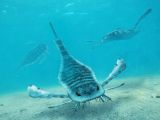Olympic Ocean
| Olympic Ocean | |
|---|---|
 Olympic Ocean | |
| Location | West Caxcana, Southwest Hesperida, South Liberalia, East Neria |
| Type | Ocean |
| Basin countries | Astoria, Comhar, Doatia, Esilie, Gardavasque, Lauchenoiria, Mansilla, Teyè, Trive, Wosteaque |
| Surface area | 122,933,000 km2 (47,465,000 sq mi) |
| Average depth | 6,740 m (22,110 ft) |
| Max. depth | 9,988 m (32,769 ft) |
| Settlements | Amgras, Tofino, Zlento |
The Olympic Ocean is the second-largest of the world's four oceanic divisions, covering 122,933,000 km2 (47,465,000 sq mi) or 19.8% of the water on the Earth's surface. It is bounded by Liberalia to the north, Neria to the west, and Hesperida and Caxcana to the east. To the south it is bounded by the Southern Ocean, and it connects through open waterways to the Tenebric Ocean.
Etymology[edit | edit source]
Geography[edit | edit source]
Coasts and Shelves[edit | edit source]
Marginal Seas[edit | edit source]
The Olympic Ocean has four seas that reside within it. The Dolphin Sea, the Galinios Sea, the Saint Elmo Sea and the Vitrecan Sea. The Galinios and the Saint Elmo Sea both connect to the Tenebric Ocean, while the Vitrecan Sea connects to the Northern Ocean.
Climate[edit | edit source]
Marine Life[edit | edit source]
-
A dolphin off the coast of Gardavasque
-
A school of surgeonfish near Cadair.
-
A group of common sea scorpions off the coast of Coatzoyuca, Mariso, Wosteaque.
The tropic zones of the Olympic Ocean host some of the largest concentration of phytoplankton blooms in summer, due to the strong monsoon winds. The monsoonal wind forcing leads to a strong coastal and open ocean upwelling, which introduces nutrients into the upper zones where sufficient light is available for photosynthesis and phytoplankton production. These phytoplankton blooms support the marine ecosystem, as the base of the marine food web, and eventually the larger fish species. The Olympic Ocean accounts for large shares of the most economically valuable tuna catch. It's fish are of great and growing importance to the bordering countries for domestic consumption and export. Fishing fleets from several nations exploit the Olympic Ocean, mainly for shrimp and tuna. Man countries, including Zamastan and Rio Palito, have placed regulations on their own commercial catches as the effects of over-fishing accelerate.
Research indicates that increasing ocean temperatures are taking a toll on the marine ecosystem. A 2018 Zamastanian study on the phytoplankton changes in the Olympic Ocean indicates a decline of up to 20% in the marine plankton in the Olympic Ocean, during the past six decades. The tuna catch rates have also declined 50–90% during the past half century, mostly due to increased industrial fisheries, with the ocean warming adding further stress to the fish species.
Coral reefs, sea grass beds, and mangrove forests are the most productive ecosystems of the Olympic Ocean — coastal areas produce 20 tones per square kilometre of fish. These areas, however, are also being or have been urbanised with populations often exceeding several thousand people per square kilometre and fishing techniques become more effective and often destructive beyond sustainable levels while increase in sea surface temperature spreads coral bleaching.
Mangroves cover large swaths of shoreline and island coast in the Olympic Ocean region, or almost half of world's mangrove habitat, of which 42,500 km2 (16,400 sq mi) is located in the island nations of Cadair and the Great Tequila's, or 50% of mangroves in the Olympic Ocean. Mangroves originated in the Olympic Ocean region and have adapted to a wide range of its habitats but it is also where it suffers its biggest loss of habitat.
History[edit | edit source]
Trade[edit | edit source]
The sea lanes in the Olympic Ocean are considered among the most strategically important in the world with more than 80 percent of the world's seaborne trade in oil transits through the Olympic Ocean and its vital choke-points, with 40 percent passing through the Strait of Vulkaria.
The Olympic Ocean provides major sea routes connecting Western Hesperida and Caxcana with Neria and Liberalia. It carries a particularly heavy traffic of petroleum and petroleum products from the oil fields of basin countries. Large reserves of hydrocarbons are being tapped in the offshore areas of Lauchenoiria, Iustos, Christos, Zamastan, Cadair and Gardavasque. An estimated 40% of the world's offshore oil production comes from the Olympic Ocean. Beach sands rich in heavy minerals, and offshore placer deposits are actively exploited by bordering countries, particularly Zamastan, Cadair, Gladysynthia, Vulkaria, Ruskayn, and Drambenburg.
